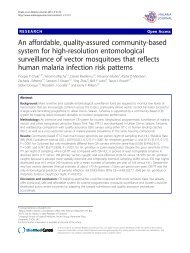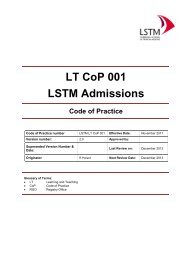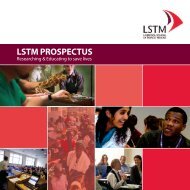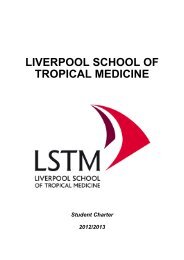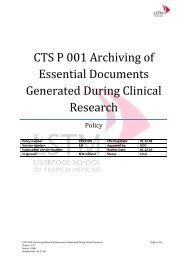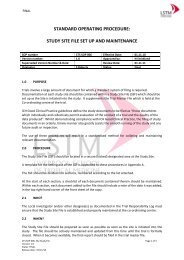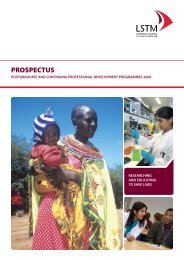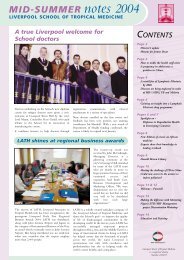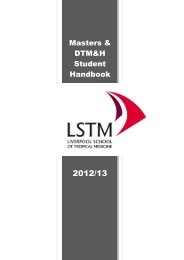Gender influences on child survival, health and nutrition: a ... - Unicef
Gender influences on child survival, health and nutrition: a ... - Unicef
Gender influences on child survival, health and nutrition: a ... - Unicef
Create successful ePaper yourself
Turn your PDF publications into a flip-book with our unique Google optimized e-Paper software.
<str<strong>on</strong>g>Gender</str<strong>on</strong>g> Influences On Child Survival, Health And Nutriti<strong>on</strong>: A Narrative Review<br />
changing <strong>and</strong> adapting to new knowledge <strong>and</strong> practices. Although they dem<strong>on</strong>strate ways in which<br />
traditi<strong>on</strong>al maternal <strong>and</strong> <strong>child</strong> <strong>health</strong> approaches have ignored household dynamics in the producti<strong>on</strong> of<br />
<strong>health</strong>, the authors do not critique this from a gender perspective which would add an important<br />
dimensi<strong>on</strong> to this issue. As this review has shown there is evidence to suggest that older women in<br />
households may have positive <strong>and</strong> negative effects <strong>on</strong> <strong>child</strong> <strong>health</strong> <strong>and</strong> nutriti<strong>on</strong> through their powerful<br />
influence <strong>on</strong> decisi<strong>on</strong>-making <strong>and</strong> access to <strong>and</strong> c<strong>on</strong>trol of resources in the household.<br />
The findings of the Aubel’s study, which c<strong>on</strong>ducted interviews at the beginning <strong>and</strong> at <strong>on</strong>e year into the<br />
interventi<strong>on</strong> found not <strong>on</strong>ly that gr<strong>and</strong>mothers’ knowledge had improved, but that women’s practices<br />
had significantly changed in the interventi<strong>on</strong> villages as compared to the c<strong>on</strong>trol villages, where<br />
nutriti<strong>on</strong> educati<strong>on</strong> was being carried out without the gr<strong>and</strong>mother participati<strong>on</strong> project.<br />
The quantitative results dem<strong>on</strong>strate that there were significant improvements in women’s nutriti<strong>on</strong><br />
practices during pregnancy <strong>and</strong> in feeding practices of newborns. In interventi<strong>on</strong> villages 98% of<br />
mothers reported initiating breast-feeding within the first hour <strong>and</strong> 96% reported exclusively<br />
breastfeeding their last <strong>child</strong> for five m<strong>on</strong>ths (compared to 57% <strong>and</strong> 35% of mothers in c<strong>on</strong>trol villages,<br />
respectively). Qualitative findings dem<strong>on</strong>strated that the pathways of change were linked into the<br />
positive roles played by gr<strong>and</strong>mothers in encouraging them to eat ‘special’ foods, to decrease their<br />
work-load <strong>and</strong> to exclusively breastfeed for the first 6 m<strong>on</strong>ths.<br />
Although the study does not explore gender issues explicitly, the authors highlight the importance of the<br />
participatory aspects of the gr<strong>and</strong>mother interventi<strong>on</strong> which was based <strong>on</strong> an acti<strong>on</strong> research model<br />
<strong>and</strong> included the gr<strong>and</strong>mothers in ‘c<strong>on</strong>structivist’ forms of learning, through s<strong>on</strong>gs <strong>and</strong> problem-posing<br />
‘stories-without-end’ <strong>and</strong> other group activities. Gr<strong>and</strong>mothers themselves reported feeling empowered<br />
by the interventi<strong>on</strong> through their heightened sense of self-esteem <strong>and</strong> improved knowledge <strong>and</strong><br />
increased interest in maternal <strong>and</strong> <strong>child</strong> nutriti<strong>on</strong>.<br />
Given that the review has c<strong>on</strong>tinually highlighted the intra-household nature of decisi<strong>on</strong>-making <strong>and</strong> the<br />
influence (both positive <strong>and</strong> negative) of senior household members, in particular mothers-in-law, this<br />
study provides a powerful analysis of an interventi<strong>on</strong> which takes into account this aspect of maternal<br />
<strong>and</strong> <strong>child</strong> nutriti<strong>on</strong> <strong>and</strong> dem<strong>on</strong>strates the value of addressing inappropriate practices through including<br />
senior female household members.<br />
2.3 ADDRESSING SOCIAL PROTECTION AND FINANCIAL INCLUSION<br />
GENDER SENSITIVE INTERVENTIONS<br />
The review highlighted a number of ways in which women’s reduced access to <strong>and</strong> c<strong>on</strong>trol of<br />
resources can impact <strong>on</strong> <strong>child</strong> <strong>health</strong> outcomes. Over the past decades there have been attempts to<br />
place more ec<strong>on</strong>omic resources in the h<strong>and</strong>s of women, often targeting mothers. As with participatory<br />
approaches, the rati<strong>on</strong>ale for such attempts has drawn largely <strong>on</strong> arguments that the empowerment of<br />
women will have broader c<strong>on</strong>sequences for their families <strong>and</strong> for society in general. Micro-credit<br />
schemes <strong>and</strong> cash transfer programmes have been developed <strong>and</strong> implemented widely across low <strong>and</strong><br />
middle income countries following this rati<strong>on</strong>ale.<br />
Micro-credit schemes have become a popular development tool traditi<strong>on</strong>ally involving the targeting<br />
of small ‘micro’ loans to groups of women who are then expected to use their loans to develop small<br />
businesses that can improve their livelihoods <strong>and</strong> so have a lasting effect <strong>on</strong> their families. The<br />
c<strong>on</strong>cept of micro-loans to women was originally c<strong>on</strong>ceived as a form of gender empowerment but<br />
54



